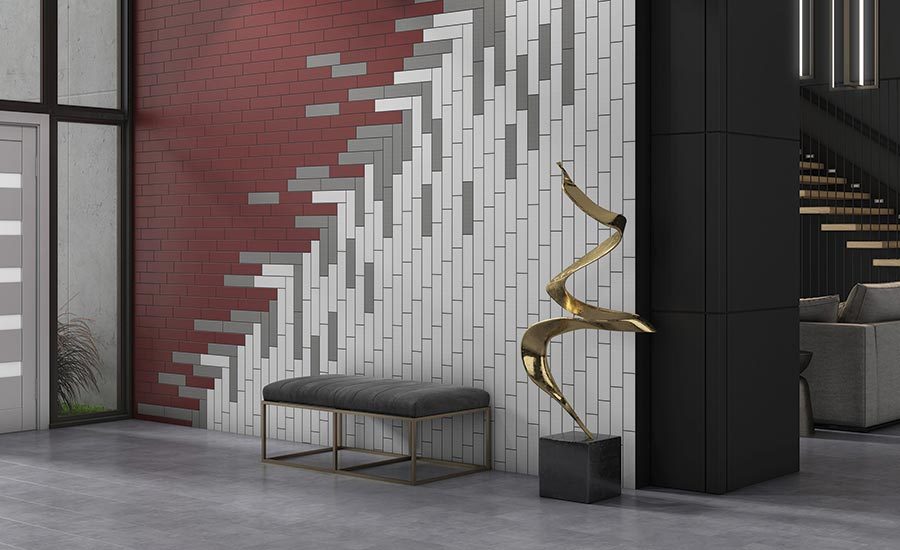Flooring retailers and manufacturers are starting to see an uptick in business, even as they continue to adjust their strategies during the pandemic. Long sought after for both commercial and residential interiors, tile leads sales now as collections feature more choices than ever before—with unparalleled designs to suit any application.
“We used to have light beige, medium beige, and dark beige options. There were just a few palettes, and that’s what simplified the business. The tile industry has really become a fashion industry. Today, it’s all about colors, patterns, and sizes,” said Frank Arnone, national sales manager, retail, Emser Tile.
Such sophisticated collections are helping to keep sales robust, no easy feat in these uncertain times. As projects resume and budgets are increased, tile is being selected to decorate a variety of spaces, from simple powder rooms to expansive lobbies. Industry professionals agree that because a range of unique looks can be achieved with tile, it has a distinct advantage over other flooring.
“I have been seeing more of what I call ‘mashups.’ The digital printing process in terms of emulating stone, concrete, wood has gotten so good. Manufacturers have almost run out of materials and now they are creating their own looks. If they can think it up, they can make it,” said Katie Michael-Battaglia, design director, Nemo Tile + Stone.
Arnone agreed, and said tile flooring has become a front-and-center component that can withstand heavy traffic. “It’s just amazing how the technology has advanced. With ink-jet printing and high-definition photography, there really isn’t any look you can’t create. We can even develop a tile that looks like carpet, and it will hold up.”
The large-format tiles are in demand, in stone styles from travertine to marble. “The large-format tiles, we’re talking 24 x 48, 48 x 48, are selling. People want a marble or granite look with a high polish. It’s lighter, brighter, and cleaner,” said Chris Cosentino, president of Hadinger Flooring, a retail store in Naples, Florida.
The larger tiles create an expansive feel, which customers crave as they continue to spend more and more time at home. “We’re seeing the large formats in Carrera. In a residential master bath, you’re seeing that white marble tile,” noted Mark Shannon, executive vice president of sales at Crossville.
Bigger is not always better, especially for installers, who can find the larger sizes to be problematic. Cosentino, a former tile setter, explained that workers with proper training are meeting the demand, which shows no sign of slowing. “Those larger tiles are not easy, they can be a challenge. They take some skill to set, but they are really popular right now.”
“We’re seeing a lot more in the large formats, 40x40, 48x48. The larger tiles were slow to catch on here in the States because of the installation factor more than anything, but I think that the installers are becoming more comfortable with it,” Michael-Battaglia added.
Many in the tile industry were forced to embrace a modern way of working when the pandemic took hold, to ensure client satisfaction and keep sales steady. Shannon said it’s what has helped Crossville to stay on track and meet their company objectives.
“We went to digital platforms immediately. We moved all of our content to a central database that’s accessible to our sales organization, from technical information to product launch presentations. Our teams have all been trained on various platforms, and now everybody’s using them on a regular basis.”
Michael-Battaglia said that Nemo Tile + Stone’s improved website was designed to provide both data and inspiration to their clients, from contractors to developers. “We actually launched a new, enhanced website so that everybody can get technical information, photos, and brochures. Then we launched a visualizer tool. We have room scenes where you can upload your own photos, and create layouts. You really get to play.”
While technology helps to generate business, ultimately, tile’s selling point is that it lasts and can actually add value in the long run, giving customers incentive to spend more on flooring. “Tile is about longevity. If it’s installed properly, it can last for 20 years. Investing in the floor is going to help increase the value of your property,” Arnone explained.
Cosentino concurred, and noted that the lasting quality is another benefit of the larger sizes. “There are less grout joints on the floor or the walls when you have bigger tiles. So, you can actually see the beauty of the tile without the grout cluttering everything up and getting dirty. Stone, porcelain, and ceramic products really do add value to your home. You know that you are going to get those dollars back. I think that’s kind of what’s driving it.”
Indoor tiles continue to sell well, and Arnone predicted that outdoor options will be just as sought after. “Even before COVID-19, people were spending more time in their houses and in their backyards. They’re focusing on the design of those outdoor areas, whether it’s putting in pavers, tile around the pool, or choosing a barbecue island with a combination of stone and tile. Our dealers are inquiring about tile flooring that goes from inside to outside, and I think it’s going to be a big growth category for us.”
Learn more about the latest design trends
He added that customers appreciate the versatility of tile that can be used for interiors and exteriors, and manufacturers are poised to deliver even more. “There are so many choices today. It’s pretty exciting to see how our industry has evolved.”








